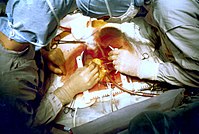
Photo from wikipedia
It has been over two decades since the very first robotic cardiac surgery was performed. Over the years, there has been an increase in the demand for less invasive cardiac… Click to show full abstract
It has been over two decades since the very first robotic cardiac surgery was performed. Over the years, there has been an increase in the demand for less invasive cardiac surgical techniques. Developments in technology and engineering have provided an opportunity for robotic surgery to be applied to a variety of cardiac procedures, including coronary revascularisation, mitral valve surgery, atrial fibrillation ablation, and others. In coronary revascularisation, it is becoming more widely used in single vessel, as well as hybrid coronary artery approaches. Currently, several international centres are specialising in a totally endoscopic coronary artery bypass surgery involving multiple vessels. Mitral valve and other intracardiac pathologies such as atrial septal defect and intracardiac tumour are also increasingly being addressed robotically. Even though some studies have shown good results with robot-assisted cardiac surgery, there are still concerns about safety, cost and clinical efficacy. There are also limitations and additional challenges with the management of cardiopulmonary bypass and myocardial protection during robotic surgery. Implementing novel strategies to manage these challenges, together with careful patient selection can go a long way to producing satisfactory results. This review examines the current evidence behind robotic surgery in various aspects of cardiac surgery.
Journal Title: Heart Lung and Circulation
Year Published: 2020
Link to full text (if available)
Share on Social Media: Sign Up to like & get
recommendations!